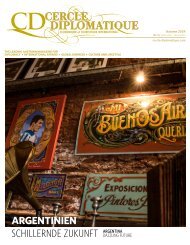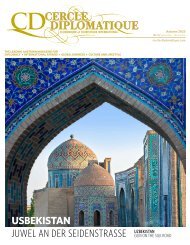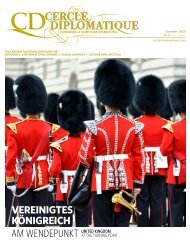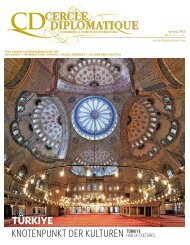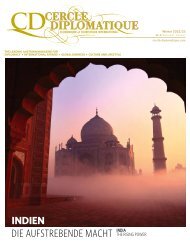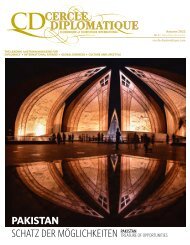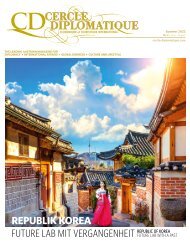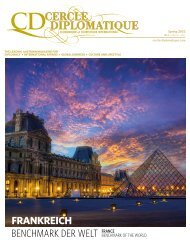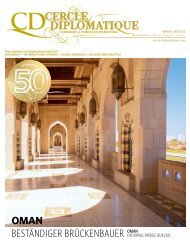CERCLE DIPLOMATIQUE - issue 02/2019
CD is an independent and impartial magazine and is the medium of communication between foreign representatives of international and UN-organisations based in Vienna and the Austrian political classes, business, culture and tourism. CD features up-to-date information about and for the diplomatic corps, international organisations, society, politics, business, tourism, fashion and culture. Furthermore CD introduces the new ambassadors in Austria and informs about designations, awards and top-events. Interviews with leading personalities, country reports from all over the world and the presentation of Austria as a host country complement the wide range oft he magazine.
CD is an independent and impartial magazine and is the medium of communication between foreign representatives of international and UN-organisations based in Vienna and the Austrian political classes, business, culture and tourism. CD features up-to-date information about and for the diplomatic corps, international organisations, society, politics, business, tourism, fashion and culture. Furthermore CD introduces the new ambassadors in Austria and informs about designations, awards and top-events. Interviews with leading personalities, country reports from all over the world and the presentation of Austria as a host country complement the wide range oft he magazine.
Create successful ePaper yourself
Turn your PDF publications into a flip-book with our unique Google optimized e-Paper software.
SAVOIR VIVRE CULTURAL DIPLOMACY<br />
Von links: Egon Schiele,<br />
Selbstbildnis, 1911.<br />
Max Kurzweil,<br />
Dame in Gelb, 1899.<br />
Dagobert Peche, Teeservice, 1922/23.<br />
From left: Egon Schiele,<br />
Self portrait, 1911.<br />
Max Kurzweil,<br />
Lady in yellow, 1899.<br />
Dagobert Peche,<br />
Tea set, 1922/23.<br />
Wiener Jugendstil im National<br />
Art Center Tokyo (oben links).<br />
Richard Gerstl, Portrait<br />
A. Schönberg, ca. 1907.<br />
Viennese Art Nouveau at the<br />
National Art Center Tokyo<br />
(top left).<br />
Judith, ein Schlüsselwerk<br />
Klimts.<br />
Judith, a key work by Klimt.<br />
Japans Einfluss auf die Wiener Moderne<br />
Eine regelrechte „Japanomanie“ hatte Europa in<br />
der zweiten Hälfte des 19. Jahrhunderts ergriffen. Japan<br />
trat aus seiner 250 Jahre andauernden Abschottung<br />
während der Edo-Zeit und präsentierte sich auf<br />
mehreren Weltausstellungen: nach kleineren Auftritten<br />
1862 in London und 1867 in Paris, 1873 mit<br />
enormem Aufwand und über 6.600 Objekten auch<br />
auf der Weltausstellung in Wien. Das europäische<br />
Publikum war hingerissen. Vor allem in Frankreich<br />
lösten die Auftritte Japans Begeisterung aus. Künstler<br />
von Vincent van Gogh bis Edgar Degas - in Österreich<br />
mit etwas Verspätung dann die Secessionisten<br />
um Gustav Klimt - waren fasziniert von der<br />
japanischen Kunst, insbesondere den ausdrucksstarken<br />
Farbholzschnitten. Viele sammelten selbst japanische<br />
Druckgrafiken, die gewichtige Impulse zur<br />
Erneuerung der europäischen Kunstströmungen<br />
beisteuerten und auch den Wiener Jugendstil entscheidend<br />
mit beeinflussten. „Das Jahr <strong>2019</strong> steht<br />
ganz im Zeichen des 150-jährigen Jubiläums der<br />
Aufnahme diplomatischer Beziehungen zwischen<br />
Österreich und Japan. Dabei steht vor allem das<br />
Kunstschaffen beider Länder im Zentrum“, betont<br />
Teresa Indjein, Leiterin der Sektion Kulturelle Auslandsbeziehungen<br />
im Bundesministerium für Europa,<br />
Integration und Äußeres. „Die Geschichte Österreichs<br />
ist der Grund, auf dem wir stehen und ich<br />
empfinde es als großes Geschenk für die Kulturdiplomatie<br />
heute, dass Österreich so stark aus Kunst<br />
und Kultur schöpfen kann“, führt Indjein weiter aus.<br />
„Man weiß vorher nie, wie Ideen und Inspirationen<br />
reisen und wirken – wie schön ist es, wenn solche<br />
Bemühungen zu ganz wunderbaren Begegnungen<br />
führen.“ Weitere Gelegenheit für inspirierende Begegnungen<br />
bieten etwa die Konzerte der Wiener<br />
Sängerknaben im Herbst in Japan, die im Gegenzug<br />
nach Österreich gereiste Sammlung der Hosokawa-<br />
Familie im Weltmuseum Wien oder die Farbholzschnitte<br />
von Kuniyoshi im Museum für angewandte<br />
Kunst, MAK.<br />
Klimt auf Reisen<br />
„Für das Belvedere ist die Ausstellung in Tokio<br />
und Toyota ein wichtiges Projekt mit internationaler<br />
Strahlkraft, vor allem in Asien“, so Stella Rollig, Generaldirektorin<br />
des Belvedere. „Gustav Klimt. Vienna<br />
and Japan 1900“ ist die größte Klimt-Ausstellung,<br />
die jemals in Japan stattfand. „Die Integration japanischer<br />
Stilmittel in Gustav Klimts Kompositionen<br />
drückt seine Hochachtung vor dieser Kultur aus. Ich<br />
denke, dies ist mit ein Grund, weshalb Klimt in Japan<br />
so beliebt ist. Wir haben einige Highlights der<br />
Belvedere-Sammlung auf die Reise nach Japan geschickt.<br />
So zum Beispiel das Gemälde Judith, eines<br />
der Hauptwerke aus der goldenen Periode in Klimts<br />
Schaffen, in dem die Bezüge zum japanischen Kunsthandwerk<br />
stark erkennbar sind.“<br />
Im Spätsommer gehen die beiden Ausstellungen<br />
dann nach Osaka und Toyota. Als Teil eines feinen,<br />
weltweit gespannten Netzes von Kulturdiplomatie,<br />
das Impulse setzt, Freundschaften zu stärken vermag,<br />
und den Kulturaustausch befruchtet – und im<br />
besten Fall die Initialzündung liefert zu etwas noch<br />
Ungesehenem, völlig Neuem.<br />
PHOTOS: THE NATIONAL ART CENTER, TOKYO; BELVEDERE, WIEN / JOHANNES STOLL; WIEN MUSEUM<br />
The Tokyo Metropolitan Art Museum in Ueno<br />
Park, the most popular park in the 14-million-people<br />
metropolis, has been enriched by<br />
another major attraction: The exhibition “Gustav<br />
Klimt. Vienna and Japan 1900”, presenting countless<br />
key works by the Austrian Art Nouveau master<br />
straight from the Belvedere Museum Vienna. And in<br />
the early summer of <strong>2019</strong>, Tokyo will be setting the<br />
stage for yet another series of key works from the Viennese<br />
Art Nouveau movement. Launched in 2007,<br />
the spectacular National Art Center Tokyo in the<br />
special ward of Minato, which – with its nearly 3 million<br />
annual visitors – counts among the most visited<br />
art museums in the world, will present various treasures<br />
from the collection of the Wien Museum in the<br />
form of the exhibition “Vienna on the Path to Modernism”<br />
– with works from Gustav Klimt and Egon<br />
Schiele to Richard Gerstl.<br />
Japanese-Austrian friendship<br />
“In Japan, there is an enormous affinity for Central-European<br />
culture. When the upcoming renovations<br />
and extensions at the Wien Museum led us to<br />
send Vienna’s treasures to travel across the world, our<br />
Japanese friends responded with particular enthusiasm,”<br />
says Matti Bunzl, Director of the Wien Museum.<br />
The occasion for Austria’s cumulative presence in Japan<br />
is the 150-year anniversary of the assumption of<br />
diplomatic relations between the two states. The formation<br />
of a friendship, trade and seafaring agreement<br />
in 1869 marked the first bilateral relations between the<br />
two countries. Bunzl considers it a great honour for<br />
the Wien Museum to be part of the festivities on this<br />
occasion. “It demonstrates our institution’s national<br />
and international importance. And it is also a great joy<br />
knowing that Vienna’s many treasures continue to enjoy<br />
fame and popularity across the world.”<br />
Japan’s influence on the Viennese Modern Age<br />
In the second half of the 19 th century, Europe found<br />
itself in the grip of a proper “Japanomania”. Japan had<br />
just stepped out of its 250 years of self-imposed isolation<br />
during the Edo period and began to present itself<br />
at several world fairs. Smaller appearances in London<br />
in 1862 and in Paris in 1867 were followed by an enormous<br />
presentation with more than 6,600 objects at the<br />
1873 Vienna World’s Fair. The European audience was<br />
delighted. Japan’s presentations were particularly celebrated<br />
in France. Artists from Vincent van Gogh to<br />
Edgar Degas – and then, with a slight delay, the Seces-<br />
sionists around Gustav Klimt in Austria – were fascinated<br />
by Japanese art and coloured woodcuts in particular.<br />
Many artists started collecting Japanese prints, a<br />
trend which contributed significantly toward the renewal<br />
of European artistic passions, including the<br />
Austrian Art Nouveau movement. “The year <strong>2019</strong> is<br />
wholly dedicated to the 150-year anniversary of the<br />
assumption of diplomatic relations between Austrian<br />
and Japan. Special emphasis is placed on the artistic<br />
endeavours of the two nations,” stresses Teresa Indjein,<br />
head of the International Cultural Policy of the<br />
Austrian Federal Ministry for Europe, Integration,<br />
and Foreign Affairs. “The history of Austria is the<br />
shoulders on which we stand and thus I regard it as a<br />
great gift for today’s cultural diplomacy that Austria<br />
can draw from so much art and culture,” Indjein continues.<br />
“You cannot always tell right away how ideas<br />
and inspirations will travel and take shape in new<br />
places – and it is so magnificent when these endeavours<br />
lead to new, unique encounters.” Additional opportunities<br />
for inspiring encounters will be the series<br />
of concerts by the Vienna Boys‘ Choir in Japan this<br />
autumn, the visit of the Hosokawa Family collection<br />
to the Weltmuseum Wien in Vienna and the colour<br />
woodcuts by Kuniyoshi at the Museum of Applied<br />
Arts, Vienna (MAK).<br />
Klimt on the road<br />
“For the Belvedere, the exhibition in Tokyo and<br />
Toyota is a major project with international appeal,<br />
especially in Asia,” says Stella Rollig, General Director<br />
of the Belvedere Museum Vienna. “Gustav Klimt.<br />
Vienna and Japan 1900” is the biggest Klimt exhibition<br />
ever held in Japan. “Gustav Klimt’s integration of<br />
Japanese stylistic choices into his compositions illustrates<br />
the respect he had for this great culture. I think<br />
that this is one of the reasons why Klimt is so popular<br />
in Japan. We have selected several highlights from<br />
the Belvedere collection and sent them on a journey<br />
to Japan.<br />
This includes the painting “Judith and Holofernes”,<br />
one of the main works from Klimt’s high point<br />
of artistic creation, displaying clear references to Japanese<br />
arts and craft.” In late summer, the two exhibitions<br />
will continue their journey to Osaka and Toyota<br />
– as part of a finely and globally cast net of<br />
cultural diplomacy, intended to set new impulses,<br />
strengthen friendships and stimulate additional cultural<br />
exchange; and, in the best case, provide something<br />
yet unseen, something entirely new.<br />
INFO<br />
Tokyo Metropolitan Art<br />
Museum<br />
„Gustav Klimt. Vienna - Japan<br />
1900“ bis 05.08.<strong>2019</strong><br />
until 05.08.<strong>2019</strong><br />
klimt<strong>2019</strong>.jp<br />
The National Art Center<br />
Tokyo<br />
„Vienna on the Path to<br />
Modernism“ bis 10.07.<strong>2019</strong><br />
until 10.07.<strong>2019</strong><br />
nact.jp<br />
Weltmuseum Wien<br />
„Die Eleganz der Hosokawa<br />
- Tradition einer Samurai-<br />
Familie“ bis 16.07.<strong>2019</strong><br />
“The Elegance of Hosokawa<br />
– Tradition of a Samurai<br />
Family” until 16.07.<strong>2019</strong><br />
weltmuseumwien.at<br />
Museum für angewandte<br />
Kunst Wien - MAK<br />
„Kuniyoshi - Witz und<br />
Widerstand im japanischen<br />
Farbholzschnitt“<br />
Museum of Applied Arts,<br />
Vienna – MAK“<br />
Kuniyoshi – Banter and<br />
Battle in Japanese Colored<br />
Woodblock Prints”<br />
27.10.<strong>2019</strong> – 16.<strong>02</strong>.2<strong>02</strong>0<br />
mak.at<br />
Alle Veranstaltungen zu „150<br />
Jahre Freundschaft<br />
Japan-Österreich“ in<br />
Österreich / Japanische<br />
Botschaft in Österreich.<br />
All events on the occasion of<br />
“50 Years of Friendship<br />
between Japan & Austria” in<br />
Austria / Japanese Embassy<br />
in Austria<br />
www.at.emb-japan.go.jp<br />
106 Cercle Diplomatique 2/<strong>2019</strong><br />
Cercle Diplomatique 2/<strong>2019</strong> 107



